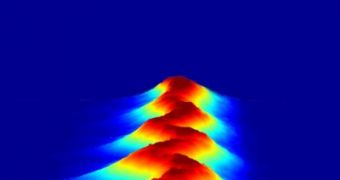A single isolated burst of extreme-ultraviolet light has been created by researchers in Italy and it's the shortest artificial light pulse yet, lasting for only 130 attoseconds (billionths of a billionth of a second).
It's been dubbed the Attoway and it is supposed to help scientists understand and control extremely rapid processes involving electrons in atoms and molecules that exist in a subatomic world that moves so fast that it's way beyond our own natural sight capabilities.
For instance, if we consider the duration of this light pulse to be of 1 second instead of 130 attoseconds, the actual second would last for 243 million years, about the same time that has passed since the first dinosaurs walked the Earth.
So, to try and understand this fast paced world, scientists will shine this ultrashort light pulse on atoms and molecules in the hope of revealing new details of their inner workings to provide benefits to fundamental science as well as potential industrial applications such as better controlling chemical reactions.
The new development was made at Italy's National Laboratory for Ultrafast and Ultraintense Optical Science in Milan (as well as laboratories in Padua and Naples) and results were encouraging, even giving them hope that their current technique will allow them to create even shorter pulses well below 100 attoseconds.
Actually, creating a single isolated attosecond pulse, instead of a train of them is quite a complex job and for this they used their previous technique employing intense short (5 femtoseconds, or millionths of a billionth of a second) laser pulses to an argon gas target and added new optical techniques, including the ones borrowed from the research that won the 2005 Nobel Prize in Physics, for creating and shaping a single attosecond pulse.
These isolated attosecond pulses promise to probe the electron phenomena such as "wave packets", which are specially modified electron waves inside atoms and molecules that may help researchers use lasers to change the course of chemical reactions for scientific and practical uses, such as controlling the breaking of bonds in complex molecules for medical and pharmaceutical applications.

 14 DAY TRIAL //
14 DAY TRIAL //